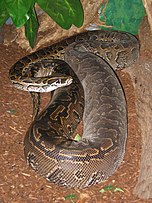
Back إمبراطورية بنين Arabic Reinu de Benín AST Benin İmperiyası Azerbaijani Бенін (гістарычная дзяржава) Byelorussian Regne de Benín Catalan Beninská říše Czech Königreich Benin German Benina Imperio Esperanto Reino de Benín Spanish Beningo Erresuma Basque
Kingdom of Benin Otedo | |||||||||
|---|---|---|---|---|---|---|---|---|---|
| 1180–1897 | |||||||||
 The extent of Benin in 1625 | |||||||||
| Capital | Edo (now Benin City) | ||||||||
| Common languages | Edo | ||||||||
| Religion | Edo Religion, Catholic Christianity | ||||||||
| Government | Monarchy | ||||||||
| Oba | |||||||||
• 1180–1246 first Oba | Eweka I[1] | ||||||||
• 2016 current Oba | Ewuare II | ||||||||
| History | |||||||||
• Established | 1180 | ||||||||
• Annexed by the United Kingdom | 1897 | ||||||||
| |||||||||
| Today part of | Nigeria | ||||||||
The Kingdom of Benin,[2] also known as Great Benin or Benin Kingdom is a kingdom within what is now considered southern Nigeria.[3] It has no historical relation to the modern republic of Benin,[4] which was known as Dahomey from the 17th century until 1975. The Kingdom of Benin's capital was Edo, now known as Benin City in Edo State, Nigeria. The Benin Kingdom was one of the oldest and most developed states in the coastal hinterland of West Africa. It grew out of the previous Edo Kingdom of Igodomigodo around the 11th century AD;[5] it was annexed by the British Empire in 1897.[6]
In the 15th and 16th centuries, the kingdom reached the height of its prosperity, expanding its territory, trading with European powers, and creating a remarkable artistic legacy in cast bronze, iron, carved ivory, and other materials.
- ^ Girshick, Paula Ben-Amos, (1995). The Art of Benin Revised Edition. British Museum Press. p. 20. ISBN 0-7141-2520-2.
- ^ "What was the Kingdom of Benin?". BBC Bitesize. Retrieved 19 June 2024.
- ^ Bradbury, R. E. (16 August 2018), "Continuities and Discontinuities in Pre-colonial and Colonial Benin Politics (1897–1951)", Benin Studies, Routledge, pp. 76–128, doi:10.4324/9781351031264-4, ISBN 978-1-351-03126-4, S2CID 159119713, retrieved 27 January 2023
- ^ "The kingdom of Benin". BBC Bitesize. Retrieved 19 December 2022.
- ^ Strayer 2013, pp. 695–696.
- ^ "The Kingdom of Benin | National Geographic Society". education.nationalgeographic.org. Retrieved 19 December 2022.

